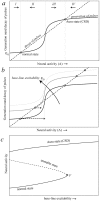Migraine strikes as neuronal excitability reaches a tipping point
- PMID: 24009688
- PMCID: PMC3757026
- DOI: 10.1371/journal.pone.0072514
Migraine strikes as neuronal excitability reaches a tipping point
Abstract
Self-propagating waves of cerebral neuronal firing, known as spreading depolarisations, are believed to be at the roots of migraine attacks. We propose that the start of spreading depolarisations corresponds to a critical transition that occurs when dynamic brain networks approach a tipping point. We show that this hypothesis is consistent with current pathogenetic insights and observed dynamics. Our view implies that migraine strikes when modulating factors further raise the neuronal excitability in genetically predisposed subjects to a level where even minor perturbations can trigger spreading depolarisations. A corollary is that recently discovered generic early warning indicators for critical transitions may be used to predict the onset of migraine attacks even before patients are clinically aware. This opens up new avenues for dissecting the mechanisms for the onset of migraine attacks and for identifying novel prophylactic treatment targets for the prevention of attacks.
Conflict of interest statement
Figures



Similar articles
-
The glial spike theory. I. On an active role of neuroglia in spreading depression and migraine.Proc Biol Sci. 1992 Dec 22;250(1329):287-95. doi: 10.1098/rspb.1992.0161. Proc Biol Sci. 1992. PMID: 1362995
-
[Neurophysiological evaluation of cortical excitability in migraine: a review of the literature].Rev Neurol (Paris). 2013 May;169(5):427-35. doi: 10.1016/j.neurol.2013.02.001. Epub 2013 Apr 18. Rev Neurol (Paris). 2013. PMID: 23602117 Review. French.
-
The pharmacological control of neuronal excitability in the retinal spreading depression model of migraine.Curr Med Chem. 2012;19(2):298-302. doi: 10.2174/092986712803414178. Curr Med Chem. 2012. PMID: 22320304
-
Brain hyperexcitability: the basis for antiepileptic drugs in migraine prevention.Headache. 2005 Apr;45 Suppl 1:S25-32. doi: 10.1111/j.1526-4610.2005.4501008.x. Headache. 2005. PMID: 15833087 Review.
-
Pathophysiology of migraine.Neurol Sci. 2004 Oct;25 Suppl 3:S239-41. doi: 10.1007/s10072-004-0295-3. Neurol Sci. 2004. PMID: 15549546
Cited by
-
Phase transitions in biology: from bird flocks to population dynamics.Proc Biol Sci. 2021 Oct 27;288(1961):20211111. doi: 10.1098/rspb.2021.1111. Epub 2021 Oct 20. Proc Biol Sci. 2021. PMID: 34666526 Free PMC article.
-
Effectiveness of eye movement exercise and diaphragmatic breathing with jogging in reducing migraine symptoms: A preliminary, randomized comparison trial.Brain Behav. 2023 Jan;13(1):e2820. doi: 10.1002/brb3.2820. Epub 2022 Dec 1. Brain Behav. 2023. PMID: 36454123 Free PMC article. Clinical Trial.
-
Critical Transitions in Ecosystems and Society. The Contribution of Sociological Systems Theory to the Analysis of Socio-Environmental Transformations.Front Sociol. 2022 Jan 24;6:763453. doi: 10.3389/fsoc.2021.763453. eCollection 2021. Front Sociol. 2022. PMID: 35141313 Free PMC article.
-
Lithium use associated with symptom severity in comorbid bipolar disorder I and migraine.Brain Behav. 2022 Jun;12(6):e32585. doi: 10.1002/brb3.2585. Epub 2022 May 5. Brain Behav. 2022. PMID: 35510536 Free PMC article.
-
Evolution of extrema features reveals optimal stimuli for biological state transitions.Sci Rep. 2018 Feb 21;8(1):3403. doi: 10.1038/s41598-018-21761-8. Sci Rep. 2018. PMID: 29467377 Free PMC article.
References
-
- Goadsby PJ, Lipton RB, Ferrari MD (2002) Migraine - Current understanding and treatment. New England Journal of Medicine 346: 257–270. - PubMed
-
- Lauritzen M (1994) Pathophysiology of the migraine aura: The spreading depression theory. Brain 117: 199–210. - PubMed
-
- Dalkara T, Zervas NT, Moskowitz MA (2006) From spreading depression to the trigeminovascular system. Neurological Sciences 27: s86–s90. - PubMed
Publication types
MeSH terms
LinkOut - more resources
Full Text Sources
Other Literature Sources
Medical

